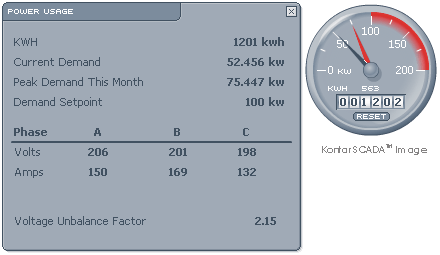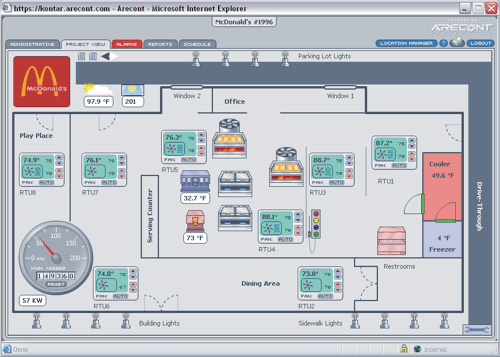September 2005
![]()
AutomatedBuildings.com
[an error occurred while processing this directive]
(Click Message to Learn More)
September 2005 |
[an error occurred while processing this directive] |
|
|
Michael Burdett, |
You don’t have to be a “peak oil” fatalist to see that the rising energy costs are not inclined to subside any time soon. Even most utility deregulation optimists would agree that depleting supplies of fossil fuels and increased world demand for energy (especially China and India) have irreversibly changed our attitudes on power consumption and will not likely provide noteworthy consumer savings in the foreseeable future. So, what does this threat of an impending energy crisis really mean? OPPORTUNITY!
|
|
|
|
|
|
|
|
|
|
|
|
|
|
|
|
|
|
|
|
|
|
|
[an error occurred while processing this directive] |
Okay, I’m not suggesting that we should revel in the tragedy of recent world events like opportunistic looters in a riot. What I am suggesting however is that we consider how fortunate we are to be in an industry that should prosper in the face of a global energy crisis (or at least the growing perception that we are facing one) rather than floundering in a depressed world economy. From a retrofit perspective the number of existing buildings that will benefit from improved power management is staggering. And new construction projects should be bolstered by new initiatives (like George W’s new Energy Bill recently becoming law), offering significant tax incentives for more efficient buildings. Also, let’s not forget peak management opportunities.
 While
there has been a minor shift in demand rate thinking, the fact remains that peak
control will be of increasing concern under deregulation and Gridwise programs.
Managing those peaks can now be met with more sophistication than ever before.
For example, Arecont’s Internet-based Kontar™ system provides what they call
“Predictive Load Shedding™.” This approach to load control differs in that they
are not just shutting down equipment to avoid peaks, but actually predicting
peak intervals and proactively finding ways to minimize them before they occur.
While
there has been a minor shift in demand rate thinking, the fact remains that peak
control will be of increasing concern under deregulation and Gridwise programs.
Managing those peaks can now be met with more sophistication than ever before.
For example, Arecont’s Internet-based Kontar™ system provides what they call
“Predictive Load Shedding™.” This approach to load control differs in that they
are not just shutting down equipment to avoid peaks, but actually predicting
peak intervals and proactively finding ways to minimize them before they occur.
Typically load control is a relatively binary function. Either the equipment stays on and consumes electricity or is turned off and saves energy. Predictive technology is different. Technological improvements in sophisticated control systems like Kontar™ now allow the capability of adding a third dimension to load management. Setpoints can be altered, equipment shed or staged, and certain tasks like refrigeration can be pre-cooled in order to wage a preemptive strike on peak loads. Let’s consider a restaurant as an example.
A restaurant is not generally considered a very good project for load shedding of equipment. Their peak intervals are typically during peak business hours (breakfast, lunch and dinner) which do not allow them much opportunity to shed equipment that might sacrifice patron comfort, quality or speed-of-service. This is where Predictive Load Shedding comes into play. Let’s say the highest peak is a lunch hour (between 12pm and 1pm), the system helps identify this interval and begins pre-cooling refrigeration units (walk-ins, reach-ins, holding equipment) by bringing the temperature down as low as can be reasonably attainable during a non-peak interval (say 11am to 12pm). Now when the twelve o’clock lunch crowd arrives it will be able to coast during these intervals up to a slightly higher than optimal, but still acceptable, range before starting in again. System alarms even help minimize loss by alerting management to cooler doors being left open too long thereby letting precious peak-time energy escape.

This same principal applies to the HVAC settings. The system can begin cooling the dining and kitchen areas a little below the optimal temperature range (but still in the comfort zone) prior to the peak intervals and then allow the units to coast through the peaks. When equipment is called for, it can be put in rotation to minimize the single-interval loads until consumption is again normalized. It doesn’t take much to have a profound effect on savings. Remember, most utility demand charges are based on the highest peak interval and the rates are then “ratcheted” to this baseline for the next month or so, sometimes up to a year! For most businesses, managing this peak as little as 80 hours out of the year can reduce utility bills significantly without having a significant impact on operations.
[an error occurred while processing this directive] Power transducers have finally come down to a price that is very affordable (when integrated into a control system like Kontar). Having the ability to monitor energy in time has created an opportunity to optimize power consumption, equipment and operations for virtually any size business. The advantage of being able to inexpensively monitor every parameter of your power (e.g. voltage, amps, power factor, unbalance, etc.) is that it can lead to less waste, more comfort, enhanced reliability and extended equipment life. For example, the performance of a three-phase motor (like those used in compressors, fans and other equipment) depends on how well the phase voltages are balanced. A small percentage of "voltage unbalance" can result in considerable motor temperature heat which will significantly shorten the life of the equipment while consuming additional electricity. Worse yet, if the problem is not corrected even new motors will continue to fail under this condition creating headaches for building owners and discomfort for occupants. Typically this condition would go unnoticed, but with a sophisticated control system the phases are monitored and can alert to an unbalanced condition before significant damage is done.
Another consideration is power factor. Many of you are already familiar with how this affects your rate, but for those of you who are not, here is a common scenario. A utility customer has his facility optimized to his equipment when the building is first constructed (power factor = approx 1). Over time equipment is added and removed without consideration for how it affects this parameter. Since the power factor is basically a way for the utility to bill for “borrowed” electricity, many utilities will adjust the demand rate based on deficiencies in the power factor. So as an example, let’s say the power factor has slipped to .91 on our building; this means the demand will increase .09 (or 9%) to adjust for the power factor deficiency. Most consumers are oblivious to this charge in their electric bill, feeling that it isn’t something they can change. This is not the case however, capacitors can be added to re-balance the power factor and bring it back in line. A good power transducer will not only be able to identify this condition, but can work in tandem with a control system to switch a bank of capacitors and help maintain a factor close to 1.
Okay, so what does all this mean? It means you should embrace the media’s overdue attention to energy costs. Go out armed with this energy-saving technology and seize this opportunity to penetrate current or even new, untapped markets. You are crusaders for energy conservation and the environment, not vultures circling the corpse of an impending energy crisis. You can make a difference while improving your bottom line in the process.
For more information on Arecont™ or the Arecont
Kontar™ System, please visit www.arecont.com or email your contact information
to info@arecont.com for a free presentation CD and a live, online demonstration.
Michael Burdett is the VP of Sales and Marketing for Arecont Systems, Inc.
[an error occurred while processing this directive]
[Click Banner To Learn More]
[Home Page] [The Automator] [About] [Subscribe ] [Contact Us]